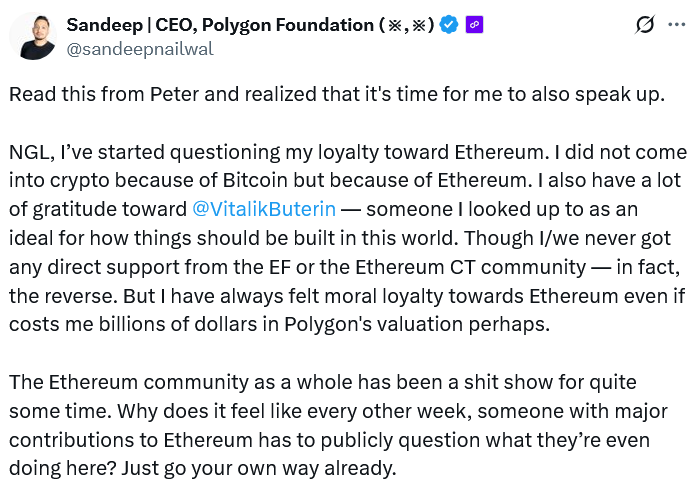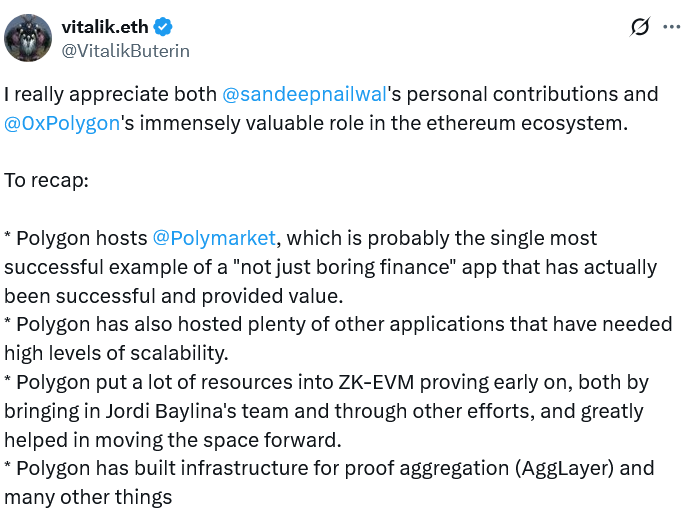Polygon co-founder Sandeep Nailwal criticized the Ethereum community for undervaluing Polygon’s contributions as a layer 2 solution, prompting a measured response from Ethereum co-founder Vitalik Buterin acknowledging Polygon’s achievements while clarifying its technical status.
-
Sandeep Nailwal questions loyalty to Ethereum due to lack of recognition for Polygon’s ecosystem support.
-
Vitalik Buterin praises Polygon’s innovations like zk-EVM and Polymarket hosting.
-
Polygon lacks full layer 2 security proofs, per Buterin, with zk tech now costing just $0.0001 per transaction.
Discover the Polygon Ethereum controversy as Sandeep Nailwal calls out undervalued contributions and Vitalik Buterin responds. Explore impacts on layer 2 scaling. Stay informed on crypto ecosystem dynamics today.
What is the Polygon Ethereum Controversy?
The Polygon Ethereum controversy stems from Polygon co-founder Sandeep Nailwal’s public criticism of the Ethereum community for failing to recognize Polygon’s pivotal role in enhancing the Ethereum ecosystem. Nailwal highlighted substantial contributions, including technological advancements and financial commitments, that have bolstered Ethereum’s scalability without adequate acknowledgment from the Ethereum Foundation or its broader community. This exchange escalated when Vitalik Buterin, Ethereum’s co-founder, responded by praising Polygon’s achievements but noting technical gaps in its layer 2 implementation.
In a detailed post on X dated October 2025, Nailwal expressed frustration over the Ethereum community’s dismissive attitude toward Polygon as a legitimate layer 2 solution. He emphasized that despite Polygon’s loyalty—manifested through decisions that potentially cost billions in valuation by not rebranding as a layer 1—Ethereum leaders have offered no direct support. Instead, Nailwal described interactions as counterproductive, urging the community to reflect on its internal dynamics.

Source: Sandeep Nailwal
This isn’t an isolated incident; Nailwal referenced broader discontent within Ethereum circles. For instance, former Ethereum Foundation researcher Péter Szilágyi shared an 18-month-old letter detailing his frustrations with the organization’s direction. Similarly, early Ethereum developer Eric Conner departed in January 2025, citing concerns over leadership decisions by Vitalik Buterin. These examples underscore a pattern of internal critiques that Nailwal’s comments amplify.
Support for Nailwal emerged from unexpected quarters. Solana co-founder Raj Gokal and former Solana Foundation strategy head Austin Federa suggested Polygon consider collaborations or integrations with Solana, positioning it as an alternative to Ethereum’s ecosystem. Such endorsements highlight shifting alliances in the blockchain space, where interoperability and recognition remain key battlegrounds.
How Did Vitalik Buterin Respond to Sandeep Nailwal’s Criticism?
Vitalik Buterin’s response to the Polygon Ethereum controversy was notably conciliatory, focusing on Polygon’s tangible impacts rather than engaging in direct confrontation. He commended Polygon for hosting Polymarket, the largest predictions market platform on Ethereum, and for pioneering zk-EVM technology that advances zero-knowledge proofs for scalable transactions. Buterin also highlighted Nailwal’s personal philanthropy through CryptoRelief, which has invested in biomedical infrastructure and research in India, demonstrating the founder’s broader societal contributions.
According to official Ethereum documentation and blockchain analytics from sources like Etherscan, Polygon’s network processes millions of transactions daily, alleviating congestion on Ethereum’s mainnet. Buterin noted that these efforts have undeniably strengthened the ecosystem, with zk-EVM implementations reducing gas fees by up to 90% in test environments. Expert analysts, including those from the Ethereum Foundation’s research arm, have previously cited Polygon’s plasma and sidechain innovations as foundational to layer 2 adoption, processing over 2.5 billion transactions since inception as per Polygon Foundation reports.
However, Buterin maintained a technical distinction: Polygon does not yet qualify as a full Ethereum layer 2 due to the absence of a robust proof system ensuring inherited security from Ethereum’s base layer. He suggested Polygon adopt readily available zk tech stacks, which have matured significantly; proving costs have plummeted to approximately $0.0001 per transaction, making implementation feasible and cost-effective. This perspective aligns with Ethereum’s scaling roadmap outlined in whitepapers from 2023-2025, emphasizing validity proofs for layer 2 integrity.

Source: Vitalik Buterin
As of October 2025, Nailwal has not publicly replied to Buterin’s remarks, leaving the dialogue open-ended. This exchange reflects ongoing debates in crypto development, where technical classifications influence funding, partnerships, and market perception. Data from Dune Analytics shows Polygon’s total value locked (TVL) exceeding $1 billion, underscoring its economic significance despite the layer 2 debate.
Frequently Asked Questions
What prompted Sandeep Nailwal’s criticism of the Ethereum community?
Sandeep Nailwal’s criticism arose from perceived underappreciation of Polygon’s role in Ethereum’s scaling efforts, including billions in foregone valuation by staying loyal as a layer 2 supporter. He cited a lack of direct aid from the Ethereum Foundation and broader community hostility, as detailed in his October 2025 X post, urging self-reflection amid internal leadership changes.
Is Polygon considered a true Ethereum layer 2 according to Vitalik Buterin?
According to Vitalik Buterin, Polygon is not yet a full Ethereum layer 2 because it lacks a proof system for comprehensive security guarantees from the mainnet. He recommends integrating zk tech stacks, now efficient at $0.0001 per transaction proof, to achieve this status and enhance interoperability naturally.
Key Takeaways
- Polygon’s Contributions Recognized: Vitalik Buterin affirmed Polygon’s value through platforms like Polymarket and zk-EVM advancements, boosting Ethereum’s overall scalability.
- Technical Hurdles Remain: Without a full proof system, Polygon falls short of layer 2 standards, but accessible zk solutions can bridge this gap affordably.
- Ecosystem Alliances Evolving: Suggestions from Solana leaders for Polygon collaborations highlight opportunities for multi-chain strategies in 2025.
Conclusion
The Polygon Ethereum controversy illuminates tensions within blockchain ecosystems, where Sandeep Nailwal’s criticism of undervalued layer 2 efforts met Vitalik Buterin’s balanced acknowledgment of achievements alongside calls for technical refinement. As Polygon continues to drive innovations like zk-EVM, integrating advanced proofs could solidify its status and foster greater collaboration. Crypto stakeholders should monitor these developments for insights into scaling futures—consider exploring layer 2 solutions to optimize your blockchain interactions today. This article was published by COINOTAG on October 2025 and last updated in October 2025.





